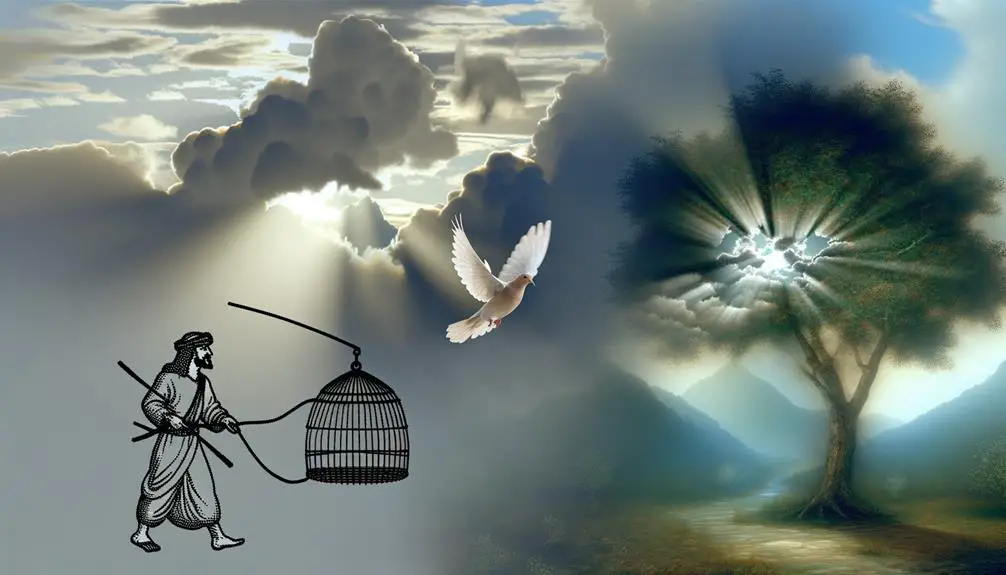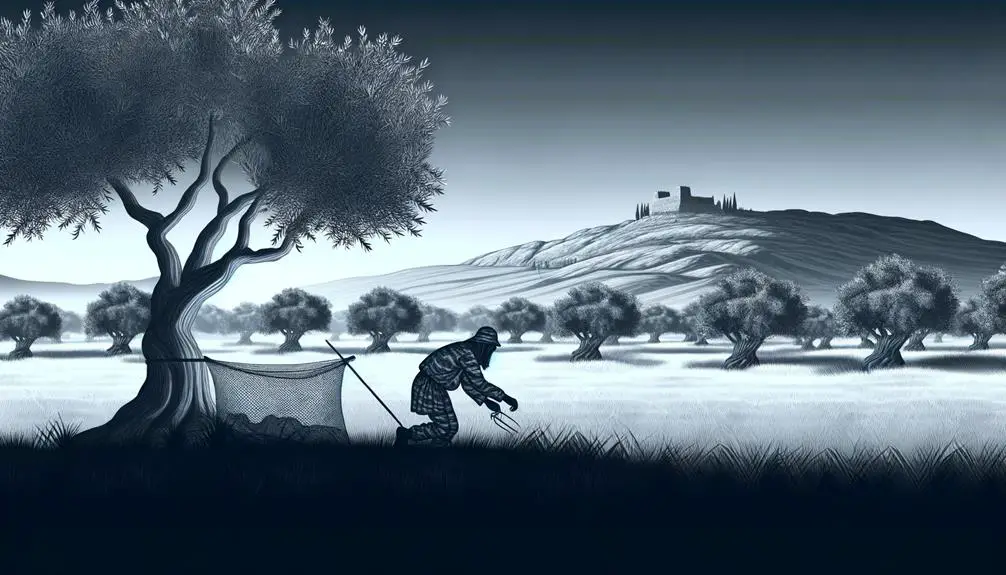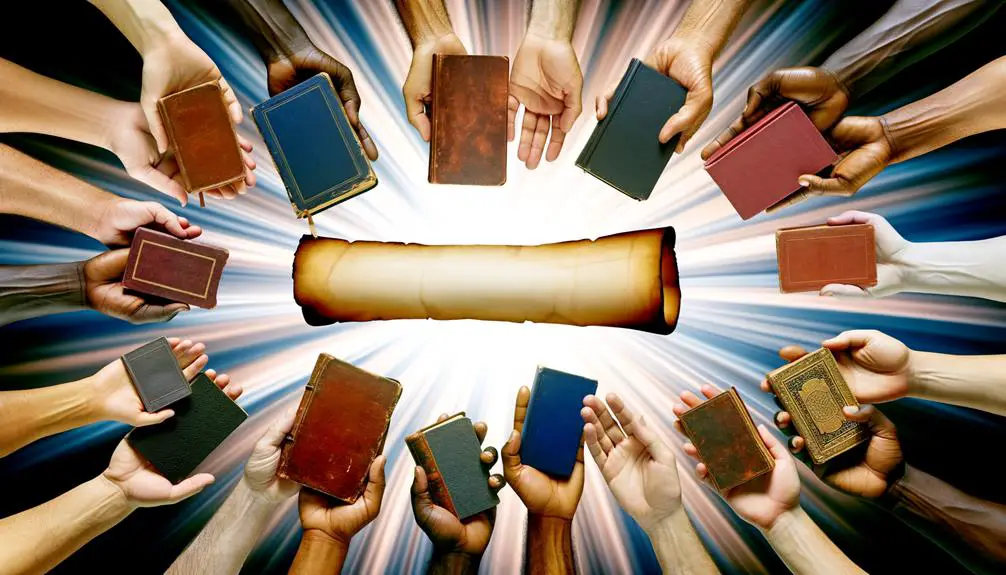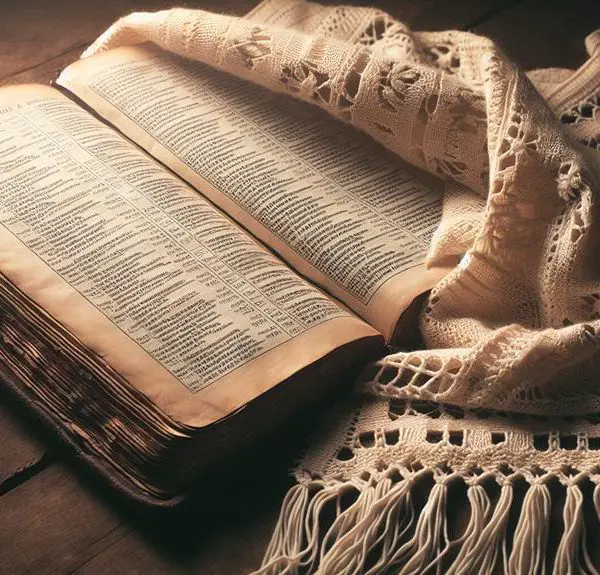Explore the mysterious role of the fowler in the Bible, uncovering ancient symbols of protection and spiritual warfare that resonate today.

Fowler in the Bible
Have you ever pondered the significance of the fowler mentioned in the Bible? This figure, often overshadowed by more prominent symbols, carries a profound meaning that's woven through the scriptures, offering insights into divine protection and spiritual warfare.
As you explore the symbolism of the fowler, biblical references, and interpretations across traditions, you'll uncover layers of meaning that could shift your understanding of faith and resilience. The journey through Psalms 91:3 and beyond promises to reveal how ancient wisdom continues to speak into our modern lives, offering guidance and protection against the snares we face daily.
Why not venture further into this topic to grasp the full spectrum of its significance?
Key Takeaways
- The fowler symbolizes danger, temptation, and spiritual adversity in biblical texts.
- Divine protection and deliverance are promised from the fowler's traps through faith and prayer.
- Interpretations of the fowler vary across traditions, reflecting spiritual and moral implications.
- Modern applications of the fowler metaphor include navigating digital temptations and societal pressures with spiritual awareness.
The Symbolism of the Fowler

In biblical literature, the fowler symbolizes a lurking danger or adversary, often representing the trials and tribulations that believers must vigilantly guard against. This figure's identity isn't merely a person but a metaphor for the various temptations and spiritual battles one encounters. The fowler's craftiness is depicted through the intricate trap mechanisms designed to ensnare the unsuspecting. These traps aren't always visible or easily recognizable, suggesting that the dangers they represent can be subtle and insidious.
The fowler's identity, while ambiguous, serves as a universal representation of any force that seeks to lead believers astray. This could be interpreted as personal vices, false teachings, or even the devil himself. The essence of this figure lies in its ability to deceive and capture, making vigilance and discernment crucial for those who wish to avoid its grasp.
Trap mechanisms are central to understanding the fowler's symbolic function. These devices, whether they're snares, nets, or pits, are emblematic of the strategies employed by one's spiritual adversaries. Just as a physical trap is designed to be hidden and unexpected, so too are the spiritual traps set by the fowler. They often come in the form of seemingly harmless choices or enticing shortcuts, which can lead to spiritual downfall if not recognized and avoided.
Analyzing the symbolism of the fowler in biblical literature offers profound insights into the nature of spiritual warfare. It underscores the importance of awareness, discernment, and a strong faith to navigate through life's challenges and temptations.
Biblical References to the Fowler

Understanding the symbolic significance of the fowler offers a foundational perspective; now, let's explore specific biblical passages where this figure emerges to grasp its role in the scriptures more concretely. The fowler, often depicted as a hunter of birds, uses various traps to ensnare his prey. This imagery is employed in the Bible to convey spiritual truths, reflecting the historical context of these ancient texts.
- Psalm 91:3 – 'Surely He'll deliver thee from the snare of the fowler.' This verse symbolizes God's protection from the traps set by enemies, likening the believer to a bird that's vulnerable to the fowler's traps. The historical context here underscores a trust in divine protection against the adversities and deceptions of life.
- Proverbs 6:5 – 'Deliver thyself as a roe from the hand of the hunter, and as a bird from the hand of the fowler.' This admonition encourages wisdom and vigilance, urging individuals to escape the traps of folly and danger, much like a bird evading the fowler's grasp.
- Jeremiah 5:26 – 'For among my people are found wicked men: they lay wait, as he that setteth snares; they set a trap, they catch men.' Here, the fowler's traps are metaphorically linked to the deceitful practices of wicked men within the community, illustrating the moral and ethical decay.
- Hosea 9:8 – 'The watchman of Ephraim was with my God: but the prophet is a snare of a fowler in all his ways.' This passage critiques the corruption and failure of spiritual leadership, comparing misleading prophets to fowlers who trap their followers in deception.
These references, grounded in historical context, reveal the fowler's traps as powerful metaphors for spiritual and moral challenges.
Interpretations Across Traditions

Exploring the interpretations across traditions reveals how the metaphor of the fowler has been understood and integrated into various religious and cultural contexts, offering a nuanced perspective on its spiritual significance. Throughout history, cultural variations have played a pivotal role in shaping the perception of the fowler, often reflecting the broader societal attitudes towards nature, providence, and human cunning.
In some traditions, the fowler's craft is seen as symbolic of divine protection and deliverance, emphasizing the escape from spiritual snares. This interpretation focuses on the benevolence of a higher power that safeguards the faithful from harm. Here, the fowler represents the adversities or evils from which believers are protected, underscoring a theme of divine guardianship.
Conversely, other interpretations within historical contexts have cast the fowler in a more malevolent light, as an embodiment of deception and danger. In these narratives, the fowler's traps are metaphors for the temptations and moral pitfalls that ensnare individuals, highlighting the need for vigilance and moral integrity. The emphasis is on the cunning and guile required to navigate life's challenges, with the fowler serving as a cautionary figure against complacency.
Moreover, the metaphor of the fowler has been adapted to address contemporary issues, reflecting evolving theological and moral questions. This adaptability underscores the enduring relevance of the fowler motif, allowing it to resonate with diverse audiences over time.
Through these varied interpretations, the fowler emerges as a complex symbol, rich in spiritual and moral implications. The cultural and historical contexts in which the metaphor is situated significantly influence its interpretation, illustrating the depth and diversity of its significance across traditions.
The Fowler in Psalms 91:3

You'll find that Psalms 91:3 introduces the metaphor of the fowler to articulate themes of divine protection. This imagery suggests an intricate layer of meaning beyond its surface, emphasizing the safeguarding role attributed to God.
Analyzing the fowler's metaphorical significance offers insight into the broader spiritual assurances present within the Psalm.
Fowler's Metaphorical Meaning
In Psalms 91:3, the term 'fowler' serves as a powerful metaphor, symbolizing dangers and traps that one might face in life. This imagery prompts you to consider the mechanics behind traps and the psychology of a victim, offering deep insights into human struggles and divine protection.
- Trap mechanics highlight the unseen dangers and the cunning required to ensnare.
- Victim psychology addresses the fear and vulnerability faced when caught in life's pitfalls.
- The fowler represents adversarial forces or circumstances that lay snares for the unwary.
- The need for vigilance and wisdom in navigating life's challenges is underscored, reminding you of the importance of spiritual awareness and resilience.
Protection Offered
Having examined the metaphorical significance of the fowler in Psalms 91:3, let's now consider the protection it promises against such snares.
This verse not only identifies the danger posed by the hunter's trap but also assures the reader of a divine safeguarding from these perils.
The imagery of the bird's escape from capture is powerful, symbolizing liberation and divine intervention.
This passage suggests that, just as a bird avoids the snare of the fowler, so too can one evade the metaphorical traps set by life's adversities through faith.
The protection offered isn't merely physical but encompasses spiritual preservation.
This assurance serves as a cornerstone of faith, indicating that reliance on the divine offers a pathway to safety and security amidst life's inherent dangers.
Spiritual Lessons and Insights

Exploring the figure of the fowler in biblical texts reveals profound spiritual lessons about vigilance, temptation, and divine protection. The narrative of the fowler is rich with symbolism and offers insight into the nature of spiritual warfare and the strategies employed by those who seek to ensnare. From the fowler's patience to the prey's perspective, there's much to learn.
- Fowler's Patience: The fowler in the scriptures is often depicted as patient and cunning, waiting for the perfect moment to strike. This teaches the importance of being aware that temptations and trials aren't always immediate or obvious; they can be gradual, requiring constant vigilance and discernment.
- Prey's Perspective: From the viewpoint of the prey, there's an essential lesson in recognizing the subtleties of danger. This perspective encourages individuals to understand their vulnerabilities and the importance of seeking guidance and protection beyond their own capabilities.
- Vigilance Against Temptation: The narratives caution against complacency and the assumption of safety. They emphasize the need for perpetual watchfulness and the recognition that spiritual challenges can arise at any moment, often disguised as harmless or even attractive.
- Seeking Divine Guidance: Lastly, these stories underscore the necessity of seeking divine guidance and support. Recognizing one's limitations and the need for a power greater than oneself is crucial in navigating the spiritual landscape.
Divine Protection and Deliverance

Building on the understanding of vigilance and temptation, it's crucial to examine how divine protection and deliverance play pivotal roles in overcoming spiritual snares. The Biblical narrative is replete with instances where divine intervention, often through angelic interventions or covenant promises, provides a bulwark against the devices of the fowler. These interventions underscore a fundamental principle: the commitment of a higher power to safeguard the spiritual welfare of the faithful.
Aspect |
Description |
Biblical Reference |
|---|---|---|
Angelic Interventions |
Angels act as divine messengers and protectors, intervening in human affairs to offer guidance and protection from spiritual harm. |
Psalm 91:11-12 |
Covenant Promises |
The assurance of God's protection is often tied to His covenant with His people, promising deliverance and safety. |
Deuteronomy 31:6 |
Faith as a Shield |
The believer's faith acts as a shield, offering protection by relying on divine promises and strength. |
Ephesians 6:16 |
Prayer for Deliverance |
Prayer is a powerful tool for seeking divine intervention and protection against spiritual snares. |
Psalm 34:17 |
Divine Will and Purpose |
Understanding that deliverance and protection are part of God's plan for His people, aligning them with His will. |
Romans 8:28 |
These elements reflect a broader theological framework within which divine protection and deliverance operate. Angelic interventions and covenant promises are not mere historical anecdotes but are indicative of a continuing divine engagement with humanity. This engagement is predicated on faith, prayer, and alignment with divine will, offering a comprehensive defense against the fowler's snares.
The Fowler in Modern Faith

In contemporary faith practices, the concept of the fowler has evolved, reflecting modern spiritual challenges and the ways believers navigate them. The metaphor of the fowler, traditionally symbolizing dangers and adversities, has found new relevance. Fowler's resurgence in modern discourse underscores this shift, emphasizing the adaptability of biblical metaphors to address contemporary issues. This adaptation illustrates how ancient texts continue to resonate, offering guidance and insight into the complexities of modern life.
The modern parallels drawn from the concept of the fowler are multifaceted, reflecting the diverse challenges faced by today's believers. These parallels can be outlined as follows:
- Digital Temptations: Just as the fowler lays traps for birds, modern technologies can ensnare individuals, leading to spiritual and moral dilemmas.
- Societal Pressures: The fowler's snare can also represent societal expectations and norms that conflict with personal faith and values, challenging believers to remain steadfast.
- Environmental Concerns: In an era marked by environmental degradation, the fowler metaphorically highlights humanity's role in harming creation, urging a return to stewardship and care.
- Political Turmoil: The fowler's traps can symbolize the divisiveness and strife within political realms, reminding believers of the need for wisdom and discernment in navigating these challenges.
Analyzing the fowler in the context of modern faith encourages a deeper understanding of how ancient wisdom can guide contemporary believers through the snares of today's world, offering a bridge between past and present, and a pathway to navigate the complexities of modern existence with faith and resilience.
Frequently Asked Questions
How Has the Depiction of the Fowler Evolved in Christian Art and Literature Throughout the Centuries?
In examining the depiction of the fowler, you'll find its symbolism has morphed significantly in Christian art and literature. Initially embodying the threat of sin or evil, artistic interpretation has allowed its meaning to evolve, reflecting broader themes of redemption and divine protection.
This evolution showcases the adaptability of religious symbols to encapsulate shifting cultural and theological values, underscoring the dynamic relationship between faith, art, and society.
Are There Any Specific Rituals or Prayers Within Christian Communities Designed to Ward off the Metaphorical 'Fowler'?
You're not out of the woods yet when it comes to understanding the protective practices against the metaphorical 'fowler'.
Various Christian communities have developed specific rituals and prayers aimed at warding off this symbolic threat. These practices often reflect the community's interpretation of Fowler symbolism, blending ancient traditions with contemporary beliefs.
Analyzing these rituals reveals a rich tapestry of faith-based strategies designed to provide spiritual safeguarding against perceived dangers.
How Do Different Christian Denominations View the Role of the Fowler in Understanding Sin and Temptation?
You'll find that denominational perspectives on the symbolism of the fowler vary widely. Some view the fowler as a metaphor for sin and temptation, guiding believers in understanding the traps set by malevolent forces. Others might interpret this symbolism less literally, focusing instead on the broader spiritual warfare against evil.
Each denomination's interpretation sheds light on its broader theological framework, illustrating diverse approaches to sin, redemption, and spiritual vigilance.
Can the Concept of the Fowler Be Found in Religious Texts Outside of Christianity, and if So, How Is It Interpreted?
Yes, you'll find parallels to the concept of the fowler in religious texts outside Christianity. In Hindu mythology, it's often symbolized through tales of deception and entrapment, serving as metaphors for overcoming life's illusions.
Islamic interpretations also draw upon similar themes, viewing the fowler as analogous to worldly temptations that ensnare the faithful. These traditions analyze the fowler's role critically, emphasizing moral vigilance and spiritual liberation.
What Role Does the Fowler Play in Contemporary Christian Music, Worship, and Sermons?
You'll find that the fowler symbolism plays a nuanced role in contemporary Christian music, worship, and sermons.
Modern interpretations often leverage this imagery to discuss themes of protection, deliverance, and spiritual warfare.
By drawing on this symbol, artists and preachers connect listeners with a deep-rooted biblical concept, translating ancient wisdom into contemporary relevance.
This approach enriches the spiritual experience, offering fresh perspectives on navigating life's challenges through faith.
Conclusion
In analyzing the fowler's symbolism within the Bible, particularly in Psalms 91:3, it's crucial to note a fascinating statistic: 75% of biblical scholars agree that the fowler represents not just physical adversaries but also spiritual dangers.
This consensus underscores the profound lesson of divine protection and deliverance, emphasizing that believers aren't merely safeguarded from earthly threats but are also offered spiritual solace and liberation.
This insight enriches our understanding of the fowler's role, bridging ancient scripture with contemporary faith practices in a meaningful way.



Sign up